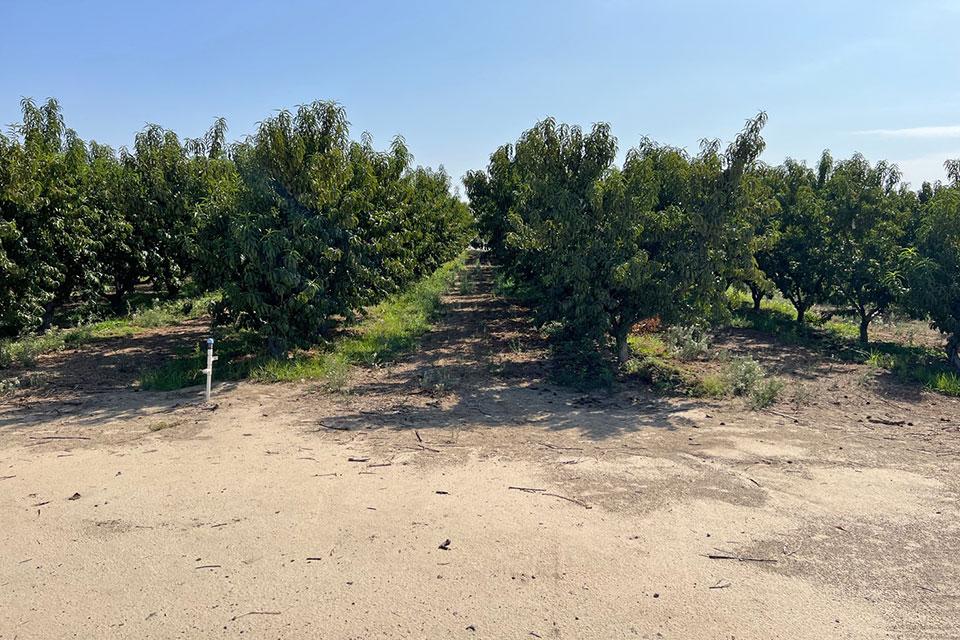How Stone Fruit Quality Follows the Light

Peach orchard with about 70% light interception, one hour before solar noon at the UC Kearney Ag Center. Note patterns of light and shade on the orchard floor.
Photo by Kevin Day
More than 40 years ago, a successful and highly respected grower told me, “The secret to an excellent orchard is not in growing a lot of fruit.”
I immediately thought, “Ah ha, the secret then is big fruit!” He then said, “Nor is it growing big fruit.” That perplexed me, and I wondered where he was headed. He concluded by declaring, “The secret is growing lots of big fruit.”
Axiomatic, but I’d never heard it put in such a concise, dramatic, and simple manner. At the time, I was aware of the idea but didn’t fully realize how diametrically opposed and challenging those concepts were.
At the existential level, fruit trees have two major purposes: 1) to keep themselves alive; and 2) to have babies and perpetuate the species. Put another way, the tree exists to grow leaves to produce photosynthates and to grow seeds to produce more trees.
These two things should always be kept in mind and are critical to orchard design, tree form, labor events like pruning, thinning, and harvesting, and other operations including irrigation and nutrition.
Basically, we deliberately sacrifice total yield to achieve better fruit size, soluble solids concentration, and other quality attributes. The tree “cares” about none of these things. It simply tries to grow as many fruit/seeds as possible given its environment. Again, our goals are in opposition to the tree’s nature.
How Much Light Is Best?
During our work in orchard systems at the University of California Kearney Agricultural Center, Scott Johnson, Ted DeJong, and I calculated that fresh market stone fruit orchards achieve optimal production when they intercept about 70 to 75% of available light*. This may seem like a low figure since approximately 25 to 30% of the light is “wasted.” Wouldn’t yields be greater if light interception were higher?
There are several things to keep in mind: 1) we sacrifice yield and limit crop to improve quality; and 2) because the sun constantly “moves,” portions of the tree are well-illuminated at certain times, and less so at others.
It’s relatively simple to have abundant light at the top of a tree, but it is challenging to do that in the interior and lower portions of the tree. Where light goes, quality follows. To achieve quality throughout the canopy, at any given time, some light must be falling on the orchard floor.
There is research in orchard nut crops supporting slightly higher light interception values (approximately 80 to 85%). In these mechanically harvested crops, the focus is principally on total yield rather than a balance between yield and fruit quality. However, it is very much worth noting that even in such orchards, it is necessary that some sunlight still falls onto the orchard floor.
So what does all this mean? If an orchard is intercepting 50 to 60% of the light available, you could expect fruit yield and/or quality improvements by capturing more light. Conversely, if an orchard intercepts less than 90% light, then improvements are possible by increasing light penetration. Potential solutions to these two extremes might include adding or removing scaffolds/branches, increasing or reducing tree height, summer pruning, or augmenting or reducing nutrients.
What’s a good way to determine orchard light interception? Once the canopy is fully developed in June/July, I suggest going out about solar noon and simply estimating the percentage of shade in four or five areas of an orchard. It may be beneficial to use a grid pattern to help.
Keep it simple. For instance, if trees are spaced 10 to 15 feet apart, then survey two 5-foot grids in one direction and three in the other — five total. Make your best estimate for each grid, add them together and divide by the number. Don’t be too precise about the detail for each grid — make it a round number like 50% shade, 90%, etc. That’s why you average multiple locations. The important thing is to give some thought to what you find and to determine if changes are needed.
*Light interception values were determined from experiments in California where summer light exposure is direct. In areas of the country with diffuse light due to cloud cover, values may be somewhat different, but the concepts are still valid.









